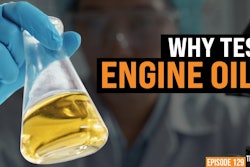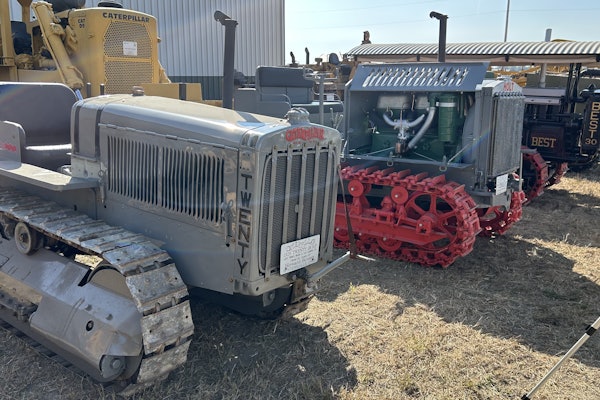Some have called it the “holy grail for earthmoving.”
Rodradar has developed the world’s first excavator bucket equipped with ground penetrating radar that detects underground utilities.
On this episode of The Dirt, we hear from company founder and CEO Moshe Dalman about how it works and get answers to questions contractors will have about the bucket, called the Live Dig Radar (LDR) Excavate.
Rodradar first unveiled the new radar bucket at ConExpo 2023, demonstrating how it can detect utility lines of all types and any material, including PVC. Rodradar has partnered with AMI attachments to develop three bucket sizes with ground penetrating radar and expects to hit he market next year.
“The operator finally has eyes to look into the ground whenever he is coming to any site and detect and avoid these utilities,” said Yuval Barnea, Rodradar vice president sales and marketing, at ConExpo.
To learn more about how the innovative LDR bucket works, check out the latest episode of The Dirt.
Equipment World serves up weekly videos on the latest in construction equipment, work trucks and pickup trucks – everything contractors need to get their work done. Subscribe and visit us at equipmentworld.com!
In This Episode:
- 00:00 - Utility Detecting Excavator Bucket
- 00:41 - What is the Rodradar LDR Excavate Bucket?
- 02:06 - What Kind of Utilities can it Detect?
- 03:19 - Does the Bucket Replace Professional Utility Locating Services?
- 04:20 - What are the Depth Limitations?
- 06:50 - How Fast Can You Remove the Rodradar Bucket and Attach a Traditional One?
- 08:52 - How Much Does This Cost? And What’s the ROI?
- 12:30 - How Can I Learn More About the Rodradar LDR Excavate Bucket?
Bryan Furnace (00:00):
Hi everybody. Welcome back to Equipment World. You're watching The Dirt. I'm your host, Bryan, and as you can see, we're in the middle of construction, so please excuse our mess as we move into our new studio. But that being said, we're coming at you today to talk about some really cool technology. We're talking about RodRadar, a ground penetrating radar bucket that allows you to find utilities on your own without a locate service and it actually works and it's pretty stinking accurate. So without further ado, we're going to talk to Moshe with RodRadar about how the system works. So this is a really exciting product, but for people unfamiliar with RodRadar, can you give us just a general overview as to how the system works and what it is?
Moshe Dalman (00:49):
So I'll start with just outlining the problem. Everybody works around utilities and we know that the information about utilities is poor and we know that it forces everybody to work slow and be very, very careful and be inefficient. And the reason for that is very simple and that is because we cannot see into the ground and this is exactly what Live Dig Radar does. And I emphasize it, it gives the operator the ability to see into the ground while digging. And this is where we differ from anybody else that is dealing with utility strikes, is that we want to empower the operator, because the operator with a machine is the one that eventually hits the utilities and is the one that wants to prevent to avoid hitting the utilities, so this is what we do. How did we do that? We embedded a sensor into a digging bucket and it's just like the radar or the camera that you have in your car that makes you a better driver. This is a sensor that tries to make the operator a better operator.
Bryan Furnace (02:06):
Is this limited to finding utilities with a tracer wire or some sort of metal conductor, or is this going to find plastic and other fiber, for instance, that doesn't necessarily have a tracer running alongside it?
Moshe Dalman (02:18):
First of all, we know that we can detect any type of utility in any type of soil. Of course, if you have a tracer wire or something metal in this utility, it's going to be easier for the system to pick it up. We're very focused on the short range. We are worried about the next bite of the bucket, so since this is what we're interested in, we are overcoming many of the limitations of ground penetrating radar. The physics didn't change, but we're looking close, we can detect things that are different from what the soil looks like to the radar from very short range and we can make the decision whether it is a utility or not. By the way, we do it automatically. We don't need any technician to interpret. Our algorithm does it automatically and presents it to the operator in a meaningful way, in a way that they can operate upon.
Bryan Furnace (03:19):
So not being limited to only metal conductor type utilities or ones with tracer wires. It sounds like even if I don't hire a private locate, I could come out here to a private residence and start digging around and I still know that as long as I have the RodRadar, I'm going to be okay finding those private utilities as well, because it doesn't discriminate between private and public.
Moshe Dalman (03:40):
It doesn't discriminate between private and public and we do not intend to make things different or change the rules. If you are using a locator before and you think it's worthwhile to use a locator again, go ahead and do it. What we're doing is that once you get with your machine on the site and you start digging, you have a last line of defense that tells you that if everything went south and the information that you got wasn't accurate or you're doing something that is different a little from the plan, you can be safe and still not hit any utilities. That's the idea.
Bryan Furnace (04:18):
Interesting. So what sort of depth limitations are we limited to? Are we talking a foot or two feet of soil? Are we only talking four to six inches? How far down can the RodRadar bucket see into the ground?
Moshe Dalman (04:31):
First of all, the most important thing is that practically, it's irrelevant. Why is it irrelevant? Because you dig. You're using the bucket. You're getting closer to the target all the time, so it doesn't matter what's the range. You need to know what's your safe space with your next bucket. Having said that, ideally, we detect everything down to three feet.
Bryan Furnace (04:56):
Oh, wow. That's far more depth than I was thinking.
Moshe Dalman (04:59):
Yeah. We detect everything down to three feet, but like in any other ground penetrating radar, everything affects your capability to detect the soil type, the utility type, so the more clayish, the less distance you see. The more metal, the better way the target can be separated from the background. And this is the part that I like most about our solution, is that on one hand, it's a cutting edge technology, because there is no more advanced ground penetrating radar in the world now and it's ours, Live Dig Radar. That's on one hand and on the second hand there is a skill factor. You need to understand what you're doing. You need to adapt the way you work to the capabilities of the tool and this is something that we've seen, that operators pick it up quite quickly and get very comfortable with using this tool.
Bryan Furnace (05:57):
So in my mind, this would best be suited, even though you can see three feet in the ground, just for a safety factor, you would almost make your pass, set the bucket flat, drag it towards you, check for utilities, do another swipe with your bucket, check really quick and that way, you're just slowly working yourself down.
Moshe Dalman (06:15):
Exactly. We call this peeling the onion and it really, really depends on what kind of soil type and how much at risk do you feel that you are. Let's say that you're working in dry sand. You can peel up down to 20 or 30 centimeters, 12 or 13 inches, but if you're working in clay and it is something that you really want to be making sure that you're going to avoid hitting, peeling layers of five, six inches at the time will give you a very, very good chance of not hitting this utility.
Bryan Furnace (06:47):
What an interesting tool. So let me ask you this, because we have electronics on this bucket obviously. How quick is it to switch over if let's say we've found our utilities, we're good to go, but I'm digging in heavy rock? I don't want to beat up my RodRadar expensive bucket. How quickly can I switch between the RodRadar bucket and a conventional bucket?
Moshe Dalman (08:24):
It's like any other bucket. The only addition is a connector that connects the system from the bucket to the cabin. That's the only difference. Down the line, we are planning to be connected with quick couplers and systems like this that will enable you to simply replace the bucket that you're digging with from the cabin.
Bryan Furnace (08:43):
So I am going to have to get out of the cab, but we're talking 10 seconds of unscrewing a connection and then you drop it like any other bucket.
Moshe Dalman (08:49):
Exactly. Even less.
Bryan Furnace (08:51):
No big deal at all. This is a pretty powerful tool. I'm sure it comes with a cost. Do you know roughly, for a cost comparison, what a conventional bucket would be versus one of the RodRadar buckets?
Moshe Dalman (09:02):
To compare between a conventional bucket and a radar bucket is unfair, because it's not apples to apples. I don't know what are the prices of other tools. I can tell you that the price for an eight ton machine in the United States is going to be somewhere in the whereabouts of $40,000 and we know from the people that are using the system that the ROI of the system is very, very quick. All you need to think about is the direct costs of hitting utilities, the fact that there's a damage that you need to prevent, there is a fine there, there's idle time and all the costs that are associated with it.
(09:40):
Also, you have to think about everything that you do for prevention that does start with hydrovacing, sometimes surveying, or hand digging that you can do less. And I didn't talk about efficiency, but all you need to do is just add this up and think about how many strikes you could avoid and how much more efficient could you be using this system and we know that you get back your investment with a couple of months and you are able to save hundreds of thousands of dollars if you're using the tool properly.
Bryan Furnace (10:14):
And that's where my mind goes. An initial knee-jerk reaction is, oh, $40,000, that's really expensive, but I sit here and think first of all, very easily with one utility strike, you could absolutely save that in the fines you're going to get from whatever utility company you just hit, but more importantly and where I think a lot of people aren't really mentally going to go right away is every time we have to expose a line in the field, it's generally one to two laborers coupled with a machine and generally, you're putting your higher end operator in that machine, because you're exposing utilities and you don't want to be responsible for a strike.
(10:49):
And you've probably got 45 minutes to an hour of very slow hand digging depending on your situation with all the utilities in the ground and no one's really taking into account just how much time I have in machine idle time and operator cost and laborer cost to slowly dig down and find those utilities versus with a tool like this, you could drop that time down to a fully exposed utility in 10 minutes maybe. I feel like that's a huge savings.
Moshe Dalman (11:16):
I agree with you. We have a customer that already, when he's having his top crew that is exposing utilities, he was able to take one person that was hand digging and move him to another team and this way, he was already making more money with the same assets.
Bryan Furnace (11:34):
Yeah. The other area I go is it's very common for us to get on private lots with private utilities, that unless you want to go fork out your own personal money and pass it through to the customer somehow, you have to hire a private locate service to come find those. They're not going to take into account things like sprinkler lines or propane lines possibly. There's a lot of other things that you're going to have to worry about versus this bucket can pick up all of those and again, we're exposing those in a third to a fifth of the time that we would conventionally.
Moshe Dalman (12:02):
Yeah. That's exactly the case. And the issue is to gain confidence with the system and understand what it can and cannot do with you and there's no other way to do that but simply use it. It's a very, very powerful tool, because the physics behind it are very paramount.
Bryan Furnace (12:21):
Well, Moshe, thank you so much for all the information. This sounds like a very capable tool. Where can people find more information on the RodRadar bucket?
Moshe Dalman (12:29):
First of all, we have a lot of information on our website and we're currently working with our partner, AMI Attachments from Ontario, Canada that I believe that many of your followers know and we are planning to make Live Dig Radar for general availability down the line sometime early 2024. We're now getting the systems ready and so on and so forth.
Bryan Furnace (12:56):
Well, as always, thank you guys for watching The Dirt. Thank you for RodRadar and Moshe for taking his time to come on the show today to discuss this really awesome technology with us. As always, I hope this helps your business and gives you some insights as to how you can become more efficient. We'll catch you on the next episode of The Dirt.










